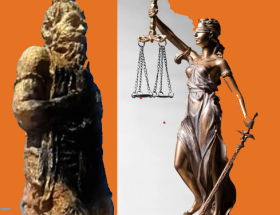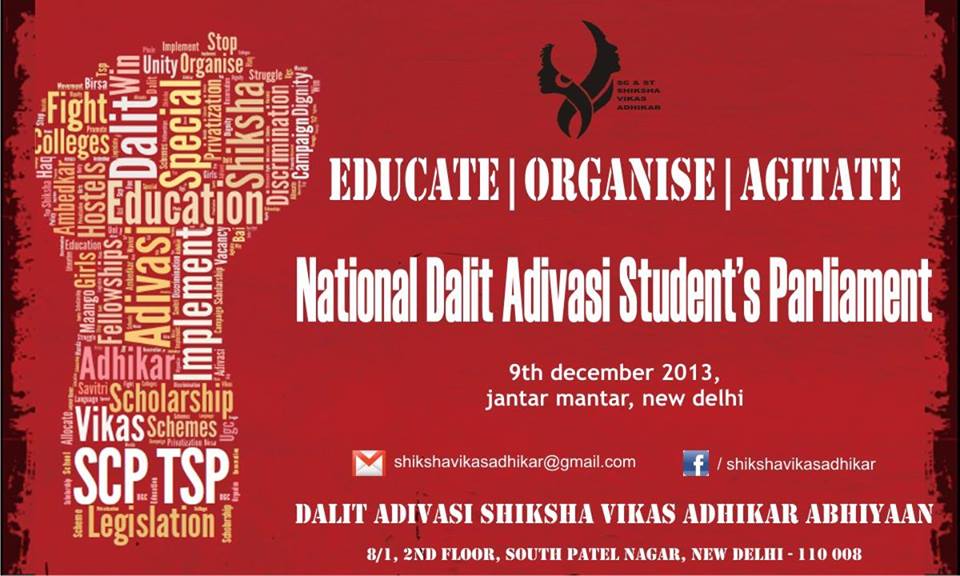Rajendra Jadhav
India & Sustainable Development Goals through the Perspective of Dalit Inclusive Disaster Risk Reduction
 Asia Dalit Rights Forum has published its report on India & Sustainable Development Goals through the Perspective of Dalit Inclusive Disaster Risk Reduction in the side event of High-Level Political Forum on Sustainable Development in New York city of USA on 10th July 2018. a brief summary of the report for the readers of Round Table India.
Asia Dalit Rights Forum has published its report on India & Sustainable Development Goals through the Perspective of Dalit Inclusive Disaster Risk Reduction in the side event of High-Level Political Forum on Sustainable Development in New York city of USA on 10th July 2018. a brief summary of the report for the readers of Round Table India.
Introduction
The Sustainable Development Goals, a 2030 Agenda, are a set of 17 Goals and 169 Targets, adopted by 193 nations. It intent of ‘Leave no one behind’ at its core. The SDGs were accompanied by the Sendai Framework for Disaster Risk Reduction and the Paris Agreement on Climate Change. These three conventions are interdependent and mutually reinforcing vehicles to inclusive, disaster and climate change resilient sustainable development. It is universally acknowledged that development that’s not disaster resilient and climate adaptive would not be sustainable by itself.
The socially excluded communities, especially the Scheduled Castes and the Scheduled Tribes, disproportionately bear the consequences of climate change. They are the first and most severely affected. They are the last to get relief and sometimes are actively prevented from getting relief. Yet, the present institutional mechanisms for disaster management do not recognize caste induced vulnerabilities.
Disaster risk reduction and climate change adaptation need to inform the social protection policy so the poor Dalits and other marginalized sections can be shielded from shocks and risks owing to climate change. The state never recognises Dalit communities as local minority communities.
India’s Vulnerability to Disasters
The Indian subcontinent is highly vulnerable to natural disasters. More than 58.6 per cent of the landmass is prone to earthquakes; over 40 million hectares of its land is prone to floods and river erosion; close to 5,700 km, out of the 7,516 km long coastline is prone to cyclones and tsunamis; 68% of its cultivable area is vulnerable to droughts; and, its hilly areas are at risk from landslides and avalanches. India was among the top three most disaster-hit countries in 2015, with economic losses amounting to $ 3.30 billion. India had 19 disaster events including floods, droughts and heat waves in 2015. India also witnessed 2248 deaths in 2015 due to heat waves. On an average 20,000 lives are lost in India every year due to natural disasters. The global assessment report estimated India’s average annual economic loss due to disasters to be $9.8 billion.
Disaster and Caste-based Discrimination
It is incontestable that disasters hit the vulnerable sections of the society such as women, persons with disabilities, and groups that are socially excluded and discriminated on the basis of their identity emanating from caste, religion or ethnicity. Globally, 260 million people face discrimination based on work and decent. According to the Arjun Sengupta Committee Report, Dalits constitute 81 percent of India’s vulnerable.
Whilst the SDGs have dedicated goals on Poverty Reduction and Reducing Inequality within and among nations, they failed to recognize caste. This was a critical lapse, and SDGs were doubted to be equipped to deal with exclusion and historic deprivation associated with caste. The SDGs do not indicate or seek to establish means by which inclusive disaster risk management would be operationalised and monitored based on the principles of equality of rights.
‘Discrimination by default’ is as much an issue as discrimination by norm and intent and is prevalent both within civil society and administration. Marginalisation of Dalits gets magnified in disasters due to historically pre-existing practices of untouchability and notion of pollution and purity. Even in cases where there is no intentional bias against Dalit communities, the lack of knowledge about their vulnerabilities, not mapping their habitations and prevalent norms of operations result in the administration not taking the cause of Dalit and other marginalized communities in times of disaster.
Aims and objectives of the report
The report is trying to bring forth the need for recognition of caste-based discrimination in disasters and the consequences of its non-recognition. It also aims to sensitize and educate the international and national communities committed to SDGs to know for themselves what these ambitious universal goals hold for the 260 million Dalit communities globally when it comes to reducing disaster risks and building resilience to rising disasters and climate change.

The Report being released in New York
Monitoring studies conducted by National Dalit Watch (NDW) have highlighted that Dalits and women have been systematically excluded from relief and rehabilitation efforts. There were reports of caste-based discrimination in access to aid, restrictions on the movement of people in camps, and exploitation and harassment of women at relief camps. Dalits continue to live in secluded habitations outside the main village thereby having lower access to information, public education, disaster resilient infrastructure or communication for immediate action. They are most prone to suffer the outbreak of diseases in times of disaster.
Economic vulnerability
Dalit households, dependent on casual and agricultural labour are particularly vulnerable to hazards as they lose their immediate employment. Landlessness and lack of productive assets make them work as sharecroppers and take to cheap manual labour for meeting their immediate survival needs.
In such a situation, Dalit and marginalised communities cannot recover without the assistance from the humanitarian agencies and the government, which often doesn’t reach them due to biased targeting.
Fear of Violence
The norms of untouchability place many limitations on how Dalits can access safety, security or relief during disasters. Continuing societal norms of pollution in using common water sources, common dining and commonplace for accommodation are prevalent in the minds of dominant caste communities. Fear of caste conflicts and internalisation of their own age-old caste status hold them back from claiming their rights.
Forms of Discrimination unveiled by Civil Society Studies
The monitoring studies have revealed the following major patterns of discrimination:
• Lack of information and early warning and timely communication by the authorities;
• Discriminatory evacuation services;
• Single women headed families; families with elderly and children alone and adults having migrated for work were left without any assistance;
• Non-enumeration and delayed enumeration leading to underestimation of losses;
• Enumeration process carried out by officials sitting in Panchayat offices where not all Dalits could gain entry for participation;
• Dalit victims who moved away to distant safer locations were not treated as flood-affected people during the time of enumeration by the officials;
• The path to reach the rescue shelters is laid through dominant caste communities that did not allow Dalits to pass through during the time of floods;
• Inappropriate registration of losses of Dalits agricultural labourers;
• Dalits were employed to clear slush in the colonies and housing of other dominant caste groups under programmes like MGNREGA, for which they were not paid their wages.
Informed and inclusive DRR and Climate Change Adaptation would require, recognition of caste vulnerabilities and marginalisation; diversity in disaster response teams across levels; and an empowerment approach with awareness on rights and entitlements, and a sound policy and budgetary provision to arrest caste induced disaster vulnerabilities.
The report intends to bring to the attention of the international and national stakeholders committed to safe, disaster resilient, and climate change adaptive sustainable development, the need for resilience planning at different levels for and with the socially excluded communities. The study focuses on disaster vulnerability and resilience needs of the communities that face caste-based discrimination in India, the Dalits.
The study focusing on following Goals
Goal 1: End poverty in all its forms everywhere
Goal 3: Ensure healthy lives and promote well-being for all at all ages
Goal 11: Make cities and human settlements inclusive, safe, resilient and sustainable
Goal 13: Take urgent action to combat climate change and its impacts
Goal 17: Strengthen the means of implementation and revitalize the global
partnership for sustainable development
The Government of India has demonstrated its commitment to sustainable and disaster resilient development by taking lead in various international and national policy declarations and actions. It also proclaimed its intentions through the Voluntary National Review Report at UN HLPF 2017.
To fast track 2030 Agenda, the Government of India has released a draft Three-Year Action Agenda covering years 2017-18 to 2019-20. It also released the National Disaster Management Plan in December 2016.
10-Point Agenda for Disaster Risk Reduction released at the Asian Ministerial Conference on Disaster Risk Reduction on November 16th, 2016, at New Delhi, India; highlighting (1) mainstreaming of DRR by all development sectors; (2) risk coverage for all- poor households to SMEs, multi-national corporations to nation states; (3) greater participation and leadership of women in disaster risk management; (4) investing in risk mapping globally; (5) leveraging technology; (6) developing a network of universities to work on disaster issues; (7) social media and mobile technologies; developing applications for all aspects of disaster risk management; (8) building on local capacity and initiatives; (9) learning from disaster experiences; and (10) bringing about greater cohesion in international disaster response to disasters.
The National Institution for Transforming India made the nodal authority to oversee SDG implementation.
The Government has taken proactive steps to institutionalising the language of DRR into its sustainable development agenda; however, when contrasted with the realities of caste-based discrimination in the country, evidenced by various studies, much remains to be undertaken at the political level.
The Government has rightly identified issues of distressed farmers battered by climate vagaries and the agrarian downturn. Severe droughts were witnessed by at least 10 states of India. Marathwada and Vidarbha in Maharashtra have been infamous for recording a high number of farmers’ suicides. As many as 3,228 farmers committed suicide in Maharashtra in 2015. Drought affects the dignity of Dalits hardest when they are reduced to beg for work. With the drying up of work, landless Dalits have just to migrate. They don’t get rations easily at the shops and are often always the last beneficiaries of any government welfare scheme. If the water crisis continues, they manage to get some water through the tankers provided by the government, but those would reach them only last.
Replacement and not Disaster Resilience
The issue of land leasing and the title is directly linked with the quantum and quality of disaster compensation one is entitled to. During several disaster situations the wage earners, agricultural labourers, sharecroppers were found to be systematically excluded from any compensation for the loss of investments. Ignorance of the loss of work days for daily wagers and food insecurity and loss of income creating an environment for debt trap for lease farmers and smallholder farmers are indicators to defining resilience. Hence, the issue is much beyond immediate relief and requires a development approach to DRR.
National and State Disaster Management Plans- Missing links
India is the first country to have a national plan for Disaster Risk Reduction in the world. However, some areas that warrant a relook include the want for a clear and practical roadmap with a timeline and fund allocation. The Plan also lacks any framework for monitoring and evaluation of the plan, besides sidestepping the need to address the special needs of vulnerable groups, which could lead to millions of women, children, disabled and elderly people as well as Dalit and tribal communities being put at further risk.
The disaster management plans also fail to take lessons from the experiences of Community based disaster management approaches the world over.
Another serious problem is the lack of appropriate vulnerability assessments, and dependence on Vulnerability Atlas of India, which does not include slow onset disasters such as droughts and sea level rise. Moreover, the poor income levels and affordability factors push Dalits to inhabit these unsafe locations.
The vulnerability is determined by the capacity or lack of it to bounce back. In the case of SCs, fragile livelihood and subdued representation and participation in local level political decision making processes for their development in peace times have rendered even the presence of Dalit village heads less effective in disasters. It was found out during the 2015 flood in Tamil Nadu that the village head belonging to dominant community prioritized relief materials and damage assessment of the people of his community As a stark contrast, issues of ineffective decision making the role of SC Village head in favour of his community was revealed during the flood in Andhra Pradesh in 2009.
Target 1.5 calls for the resilience of the poor and those in vulnerable situations, and reduce their exposure and vulnerability to climate-related extreme events and other economic, social and environmental shocks and disasters. To achieve this, the vision of the authority would have to undergo a paradigm shift, as for now, DRR is understood from the lens building codes and bye-laws in a predominant way. The approach of sustainable development through risk reduction must be ‘people-centered’, and even further, ‘vulnerable centered’.
Besides, the local government institutions have been much touted as the primary unit of decentralized governance. In practicality, even when funds are made available to the Panchayats, they lack the capacity to spend them. So far, Panchayats have been seen as vehicles for delivering development schemes, and capacity building to enabling them to think for disaster resilient development of their villages remains a vision.
According to the Ministry, during the financial year 2015-16, an amount of Rs.8,756 crore was released to the states severely affected by natural disasters. However, the states complain about the lack of appropriate India Meteorological Department (IMD) infrastructure.
In December 2017, Cyclone Ockhi, damaged settlements, over a dozen deaths, and nearly 90 fishermen remained missing. Hundreds of lives could have been saved from the ravages of Cyclone Ockhi if deep-sea fishermen were able to carry better communications gear on board and if there was a better system of an early storm warning. Similarly, during Vardah Cyclone in 2015. Thus, having sound localised early warning systems connected to the remotest and hard to reach locations is the need of the hour.
The 10-Point Agenda for Disaster Risk Reduction calls for greater participation and leadership of women in the management of risk. Participation of women in disaster risk management, in general, has not seen investment by Government, and the field has remained largely male dominant, with women as silent subjects. Coming to Dalit women, their capacity has been vastly neglected. This is where sensitization and training need to include men and women of marginalized communities to enable participation of women.
In the UN High-Level Political Forum on the SDGs, 44 countries including India have committed to do a VNR. The Government presented its achievements post-SDGs but nothing got reported on the initiatives taken for DRR.
Conclusion
Promoting inclusion will take time and political determination. Raising awareness about the consequences of leaving some people behind and recommending actions that Governments can take to avoid doing so can help generate political will. The NITI Ayog mapped the SDGs to existing interventions, Nodal and other Ministries, and invited suggestions from the public and civil society to the proposed national indicators to SDGs. However, such mapping needs to translate into a clear roadmap to implement the SDGs with identified roles for the state governments (community, civil society/private stakeholders) and a monitoring mechanism to measure progress. Despite the talks of DRR and climate resilient development, the country suffers for the want of reliable disaggregated data on disaster damages and causalities. This kind of data needs to be collected at local levels, and available to the government at all levels, and to the public, for informed policy actions. The Government thus needs to draw up a quick plan to overcome the want for quality data.
Even though India has demonstrated its commitment to sustainable development agenda and /through parallel actions on disaster resilience and climate action, ‘Disaster Vulnerability’ need to be unpacked from the perspective of social exclusion/inclusion, by making the experiences and aspirations of marginalised and socially excluded count. The pre-existing social, physical, geographical, cultural, political and economic must be analyzed to inform any of the disaster management plans and strategies at all levels. This also requires the need to necessarily include the marginalised local populations at all levels of preparedness and mitigation efforts, with capacitated community leadership. This leadership needs to be supported to work in tandem with PRI members, in ensuring their local knowledge of the vulnerabilities is considered in decision-making planning.
A people-centered approach is the need of DRR to make development for people and nation sustainable. Different humanitarian actors need to invest and collaborate with local community-based organisations and organisations headed by /of marginalized communities. Last but not the least, public education and awareness are second to none in terms invoking agency of people in the achievement of the SDGs. Information about local Risks, Prevention and Response services of the Government need to penetrate the communities inhabiting unsafe regions. SDGs will have to be localized and connected with the wants and aspirations of the marginalized communities, and so should the disaster risk reduction approach be.
~~~
Rajendra Jadhav is Currently working with National Dalit Watch – NCDHR as a research and advocacy coordinator. He is a writer, researcher, trainer and grass root activist. He has done his master from Tata Institute of Social sciences. He was actively involved in students movement in Maharashtra for 10 years and also worked with Dalit Farm Laborers. He was a program director for PUKAR’s Youth Fellowship Program for 4 years.










